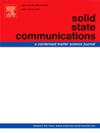SILAR synthesis of binder-free, nanosheets-like manganese phosphate electrodes for Mg-ion supercapacitors
IF 2.1
4区 物理与天体物理
Q3 PHYSICS, CONDENSED MATTER
引用次数: 0
Abstract
The present work describes the successive ionic layer adsorption and reaction (SILAR) approach to binder-free synthesis of hydrous manganese phosphate [Mn3(PO4)2·7H2O] electrodes for Mg-ion supercapacitors. Structural and morphological analysis confirms the formation of microflowers composed of nanosheets of monoclinic Mn3(PO4)2·7H2O electrodes. The binder-free MP3 electrode with optimum thickness and a specific surface area of 16.3 m2 g-1 achieves the utmost specific capacitance (Csp) of 317 F g-1 at 1 A g−1 current density in MgSO4 electrolyte. The aqueous Mg-ion symmetric supercapacitor (Mg-ASS) device (SS/MP3//MgSO4//MP3/SS) demonstrates a Csp of 73 F g−1 and specific energy of 40.5 Wh kg−1 at 2 kW kg−1 specific power. The results showcase SILAR method is feasible to prepare binder-free Mn3(PO4)2·7H2O electrodes, contributing to the sustainable advancement of Mg-ion supercapacitors.
用于镁离子超级电容器的无粘结剂、纳米片状磷酸锰电极的SILAR合成
本工作描述了连续离子层吸附和反应(SILAR)方法在无粘结剂合成水合磷酸锰[Mn3(PO4)2·7H2O]镁离子超级电容器电极中的应用。结构和形态分析证实了由单斜Mn3(PO4)2·7H2O纳米片电极组成的微花的形成。在MgSO4电解质中,当电流密度为1 a g−1时,无粘结剂的MP3电极的最佳厚度和比表面积为16.3 m2 g-1,最大比电容(Csp)为317 F g-1。水相镁离子对称超级电容器(Mg-ASS)器件(SS/MP3//MgSO4//MP3/SS)在2 kW kg - 1比功率下,Csp为73 F g- 1,比能量为40.5 Wh kg - 1。结果表明,SILAR法制备无粘结剂的Mn3(PO4)2·7H2O电极是可行的,有助于镁离子超级电容器的可持续发展。
本文章由计算机程序翻译,如有差异,请以英文原文为准。
求助全文
约1分钟内获得全文
求助全文
来源期刊

Solid State Communications
物理-物理:凝聚态物理
CiteScore
3.40
自引率
4.80%
发文量
287
审稿时长
51 days
期刊介绍:
Solid State Communications is an international medium for the publication of short communications and original research articles on significant developments in condensed matter science, giving scientists immediate access to important, recently completed work. The journal publishes original experimental and theoretical research on the physical and chemical properties of solids and other condensed systems and also on their preparation. The submission of manuscripts reporting research on the basic physics of materials science and devices, as well as of state-of-the-art microstructures and nanostructures, is encouraged.
A coherent quantitative treatment emphasizing new physics is expected rather than a simple accumulation of experimental data. Consistent with these aims, the short communications should be kept concise and short, usually not longer than six printed pages. The number of figures and tables should also be kept to a minimum. Solid State Communications now also welcomes original research articles without length restrictions.
The Fast-Track section of Solid State Communications is the venue for very rapid publication of short communications on significant developments in condensed matter science. The goal is to offer the broad condensed matter community quick and immediate access to publish recently completed papers in research areas that are rapidly evolving and in which there are developments with great potential impact.
 求助内容:
求助内容: 应助结果提醒方式:
应助结果提醒方式:


